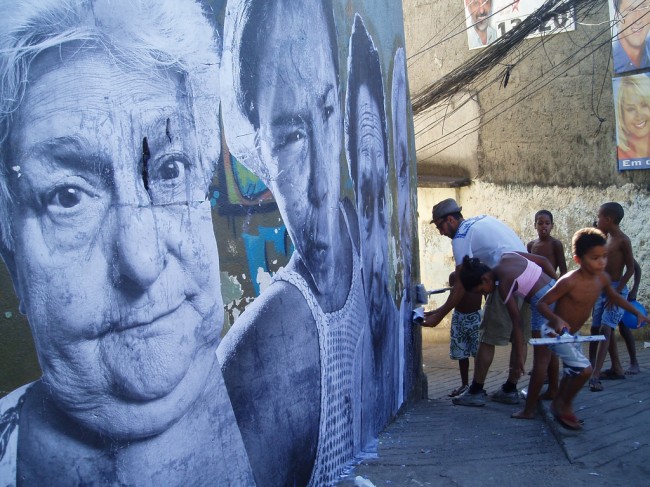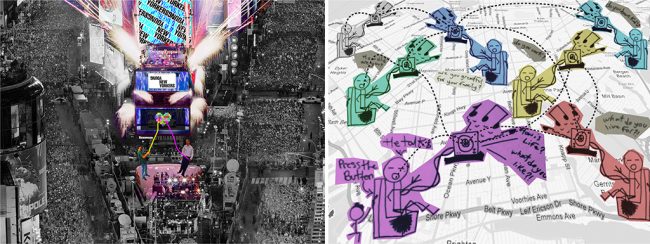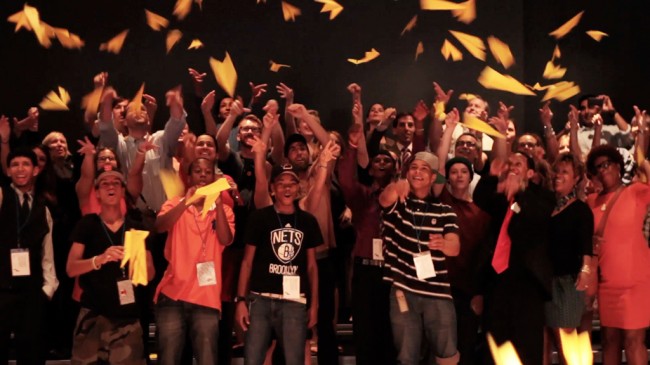
We are celebrating 15 years — and counting — of stories that are deeply researched and deeply felt, that build a historical record of what the city has been.
We are celebrating 15 years — and counting — of stories that are deeply researched and deeply felt, that build a historical record of what the city has been.
In 2011, Rachel Barnard graduated from Columbia University’s Advanced Architectural Design program with an interest in pursuing what she describes as the relationship between urban artifacts, landscape, and the social realm. Upon graduation, she received the Percival and Naomi Goodman Fellowship, an award bestowed on an individual from the Graduate School of Architecture, Planning and Preservation (GSAPP) to carry out a “project of social significance” that is “strongly humanist and excite[s] the possibility that lives can be changed for the better.” Barnard’s winning proposal was one based on her belief in the potential for public art to serve as both platform for open debate and megaphone for the underrepresented — in this case, adolescents in the New York City criminal justice system who are prosecuted and sentenced as adults. The project, Young New Yorkers, quickly evolved from a public art project into a court-mandated Brooklyn-based restorative justice program that provides an alternative to incarceration for 16- and 17-year-olds convicted of misdemeanors.
The philosophy of restorative justice is that our criminal justice system is too reliant on incarceration for low-level offenders, and that community-based sanctions and programs that focus on accountability, rehabilitation, and repairing the harm caused by criminal behavior can break cycles of offense and recidivism and emphasize ways individuals can contribute meaningfully to society. For young offenders, this kind of early intervention outside of a jail setting can prevent escalation of criminal behavior and cultivate stronger understanding of civic and personal responsibility, while also allowing adolescents to answer for their actions without being saddled with lifelong criminal records. The Young New Yorkers curriculum was shaped to adhere to those principles, and focuses on “taking responsibility for past actions as a necessary step before becoming valued members and even leaders of one’s community.” Through workshops and assignments utilizing photography, video, illustration, and design, the participants explore themes of community, choice, accountability, responsibility, contribution, and leadership. Below, Barnard shares the story of the first installment of the Young New Yorkers program and reflects on the potential legal, social, and urban significance of an art- and architecture-based approach to restorative justice. —V.S.
The wide-angle lens captures the flickering of a fan overhead and the outstretched leg of a small child sitting just out of frame. It is summer in New York and Isaiah’s grandmother is sitting on a quilted day bed that has been pushed up against a wooden partition and partially obstructs the entrance to her kitchen. Her left leg is neatly curled under her right; her left arm props herself up on the bed’s surface. Her head, framed by long braids, leans intently forward. She speaks directly into the camera her grandson is holding:
I was sad because its not like you committed a crime like you robbed someone, or you beat up someone, or you killed someone. It broke my heart that for such a minor offense you had to face the crime. Because it is a crime. Whether you do graffiti, whether you jump the turnstile, they are all crimes.
Isaiah is interviewing his grandmother as part of a homework assignment for Young New Yorkers, a restorative justice arts program for 16- and 17-year-olds with open criminal cases. The assignment asks Isaiah, and his fellow participants, to interview people important to them about the personal impact of their misconduct. Isaiah’s grandmother’s response is typical of a guardian or mentor, a combination of belief and encouragement coupled with utter frustration:
There is no excuse for jumping a turnstile.[1] Because, yeah we’re not rich people, but if you come over here and you need money to go home you know I will give it to you. And if your mother doesn’t have what you need to get to where you’re going: Just. Don’t. Go. It is not worth it! To be behind bars over jumping a turnstile!
…
Use your graffiti as an art. Go to school. Get formal training. Let someone hire you, commission you. Maybe one day you will be in a museum. Graffiti is an art. Use your talent the correct way to earn a living. Make it a career doing something that you love.
The Young New Yorkers program originated as a public art project, for which I was awarded the Percival and Naomi Goodman Fellowship for an “architectural project of social significance” from Columbia University’s Graduate School of Architecture, Planning and Preservation. In collaboration with Brooklyn Defender Services, and in particular public defender Sara Feinberg, Esq, Young New Yorkers began as a way to investigate the “geography of incarceration and return” that Eddie Ellis, a long-time activist on behalf of impoverished, criminalized, or incarcerated populations, first brought to light decades ago. While serving a 25-year sentence, Ellis created a “prisoner’s think tank” at Greenhaven Correctional Facility that found that 75% of the prisoners in New York State come from a handful of neighborhoods in New York City. The imbalance between the public money spent on incarceration and the investment in social services in these neighborhoods has inspired a number of research projects and policy interventions over the years, including Laura Kurgan’s Million Dollar Block project (2005). This project reframes police data to generate a series of maps that visualize the disproportionate number of incarcerated people whose home addresses are concentrated in just a few blocks within these neighborhoods. Our proposal aimed to zoom in and give human voices to this urban phenomenon with a particular focus on 16- and 17-year-olds in the criminal justice system who had been arrested, prosecuted, and sentenced as adults.
New York and North Carolina are the only two states in the US that continue to prosecute and sentence 16- and 17-year-olds as adults. Neurologists have long demonstrated that the area of the brain that controls reasoning, consequential thinking, and impulses — known as the Prefrontal Cortex — is not fully matured until well into one’s twenties, particularly amongst men. On the basis of this research, recent decisions of the United States Supreme Court have recognized that incomplete neurological development translates into a lesser ability to understand the consequences of one’s actions and consequently into a lesser culpability for crimes committed.
The collateral consequences of a 16- or 17-year-old being sentenced as an adult and in turn incurring a criminal record can be devastating on a young life, narrowing one’s chances of completing high school, attending college, finding a career, or accessing many welfare and housing benefits.
Yet these teenagers who are arrested, prosecuted, and sentenced as adults are too young to vote and impact the legislation that affects them the most. Krzysztof Wodiczko, an artist whose oeuvre interrogates the politics of the public sphere, often through large-scale projections on facades and monuments, argues for the importance of giving a “public voice” to those most often denied one:
…public space is often barricaded and monopolized by the voices of those who are born to speak and prepared to do so. First it is done at the expense of those who cannot speak because they have no confidence that anyone will listen to them. Historically they have good reason not to be confident. Second, they have no developed language. Yet, these are the most important speakers in a democracy. They should speak because they have directly experienced its failures and indifference.[2]
Art historian and critic Rosalyn Deutsche further argues in her influential writing on the public sphere that a truly public artwork goes beyond the occupation of a physically accessible space or the representation of a perceived public interest. Rather, it should emerge, in her view, out of an engagement with people in a public, political debate. The Young New Yorkers project was created to give teenage participants a voice, through community-specific art projects, that would make public their experiences with, and hopes for, New York State’s treatment of adolescents in the criminal justice system. That is, to impact the public conversation around adolescents’ treatment in the criminal justice system through their own public, creative self-expression.
In February 2012, Chief Judge of the New York Court of Appeals Jonathan Lippman launched the Adolescent Diversion Program (ADP), a New York State initiative to link 16- and 17-year-olds in the criminal justice system to community-based interventions. In conversation with the Honorable Judge Gubbay and with across-the-board support of Brooklyn Defender Services, Brooklyn Legal Aid, and the Brooklyn District Attorney, and administered through the Center for Court Innovation, our program became court-mandated. That is, the criminal court gave eligible adolescent defendants the option to participate in Young New Yorkers rather than do jail time or adult community service, and thereby avoid a lifelong criminal record. Young New Yorkers became an alternative to adult sentencing.
Our original framework for the public art project hinged on one message to our participants: You have something important to say. Its rapid evolution into a restorative justice program demanded that we expand this core idea into something far more powerful: You have something important to say; however, in order for others to listen, you first need to take responsibility for your past actions.
This emphasis on “taking responsibility” became the foundation for most of the assignments and workshops we embarked on during our first installment of the project, six weeks of sessions with eight adolescents in the spring of 2013.
In class, participants interviewed one another about why they were there and what they value in their lives at home and in their neighborhoods. In a language exercise, the participants listed words that have been used to describe them in different contexts: with friends and family (“son,” “brother,” “friend”), in court or surrounding their arrests (“defendant,” “criminal,” “monster,” “screw-up”), and how they wish to be talked about in the future (“success story,” “good,” “cool,” “leader”). Homework assignments included video interviews with family members about the effect of criminal behavior on others, such as the conversation between Isaiah and his grandmother.

JR’s Women are Heroes, Rio de Janeiro | Photo via Adriana Ferreira Silva
We talked about public art, and portraiture in particular, and who is represented in public space and why, such as Wodiczko’s proposal for The Homeless Projection in Union Square (1987). We looked at JR’s project in Rio Women are Heroes, in which he pasted huge photos of the eyes of local women on many of the rooftops of the favela. We discussed why it was significant that the members of the favela were represented publicly and at a monumental scale. Carlos, one of the participants in the program, offered, “It’s like everyone is usually looking down on them but now they are looking back.” We considered issues of “permission” for vast public projects, such as haas&hahn’s mural projects in Brazil among others, and what makes a community art project meaningful rather than just a solitary disruption in public space or illegal graffiti. We discuss how the Young New Yorkers program itself might be considered a community art project.
All of these exercises, whether classified primarily as restorative or artistic, were geared toward fostering positive social connections between the participants. As Oakley Ogden, our contributing therapist, put it: “it doesn’t matter how cool your program is, it is a friendship that will have a young person return.” Getting the participants to return to each class is paramount. If a participant misses two classes they will be breaking their court mandate and will return to court, likely facing a tougher sentence. 100% of our inaugural participants completed the program successfully.
After the participants considered the social effects of their behavior, they began to investigate the impact of their crime in terms of choice, accountability, and responsibility. During an intense two weeks guided by therapists, social workers, teaching artists, and myself, the participants explored these themes in conversation with the group and through art exercises utilizing photography, video, illustration, and design.
One day, we took a photography field trip, starting at a Brooklyn police precinct and ending at the Brooklyn courthouse, as a way for the kids to make sense of the experience of their arrests. The participants told their stories, and some re-enacted their experiences. One 16-year-old described how scary it was to be handcuffed as he turns around, as though shoved against the police van, with his hands twisted high behind his back. He looked back across his shoulder and smiled as someone else took his photograph. The group took photographs of locks on the back of police vans, of the court building from different angles, of the jelly sandwiches visible through the transparent trash bags discarded on the sidewalk. We heard a lot of loaded talk about the jelly sandwiches, the meal they were repeatedly given to eat as they waited for up to 24 hours in a cell in the courthouse basement for arraignment.
These photographs make visible the adult path from arrest to arraignment for 16- and 17-year-olds, but also remind us of their youth. Two participants showed me the gates inside the tunnel where police vans, carrying arrested individuals, enter the basement of the courthouse, and describe the sound of those gates closing as the moment “when you feel scared in your gut.” Yet later, they pose in front of the tunnel like other teenagers might in front of a tourist destination: with goofy grins, giving a thumbs up.
During the fifth week, we revisit the idea of choice, this time by projecting into the future. What personal characteristics do we need, what choices do we have to make, in order to be who we want to be? Lenny Correa, one of our teaching artists, taught the young New Yorkers about visual metaphors and showed them his own artwork, in which he creates portraits of individuals with sparrows atop their heads, or with tiger bodies, or eagles wings and so on. The participants set about collaging and illustrating their self-portraits with images of animals that represent who they want to be with visually moving results. The Young New Yorkers combined themselves with courageous black and gold tigers, or with snakes who would not be stopped by obstacles, or wise wolves and soaring eagles.
The workshops culminated with the development of public art proposals that addressed a social issue of each participant’s choosing.

(L) “You Can Control Your Life Like You Can Control a Video Game” by Victor | (R) “Beyond Territories” by Carlos
Victor proposed to transform Times Square into an enormous video game where people from different backgrounds (and different gang alliances) could come together and play. Carlos proposed “Beyond Territories,” a series of signal boxes dispersed throughout Brooklyn that could receive and respond to voice messages. The project aimed to create positive connections and understanding between communities that may typically experience conflict.
Isaiah observed that many billboards in his neighborhood were vacant, and suggested that those charged with graffiti infractions could be sentenced to paint artwork on the billboards. Daniel proposed a design for a glass-recycling bin, a project he titled “Glass to Art.” The revenue raised from returning the glass to manufacturers was to be used to purchase materials for community art projects.
Sachin observed that in his neighborhood people often forget their dreams. In his proposal, “Fly High,” he imagined that every year hundreds of people could gather on the Brooklyn Bridge, make a paper plane, and write their dreams on them. Together they would then throw their dreams off the bridge in a spectacle of color and promise for the future. On August 27, 2012, at an event we hosted to mark the conclusion of the workshops, we realized Sachin’s proposal, albeit in an indoor setting. At the event, Sachin approached every single guest — in a crowd that included judges, district attorneys, public defenders, court staff, his fellow participants, and their relatives and friends — and asked each person to make a paper plane and write their dreams within the folds. To complete the evening, over a hundred people stood together and, on Sachin’s count of three, threw their paper plane dreams into the air.

Still from video by Dave Regos
NOTES:
[1] Jumping a turnstile to evade subway fare is charged as trespassing (a misdemeanor and a violation of the law) and a theft of services (a misdemeanor).
[2] Krzysztof Wodiczko, Patricia C. Phillips, “Creating Democracy: A Dialogue with Krzysztof Wodiczko,” Art J 62 (2006): 36.
The views expressed here are those of the authors only and do not reflect the position of The Architectural League of New York.
Comments